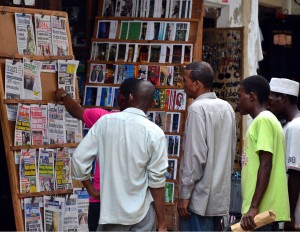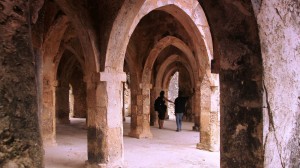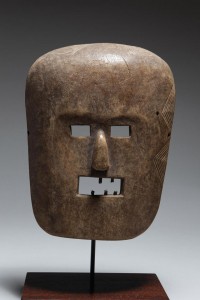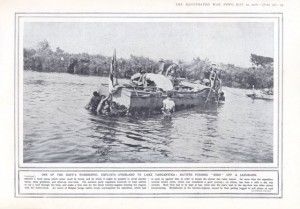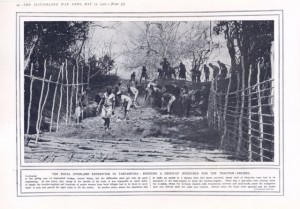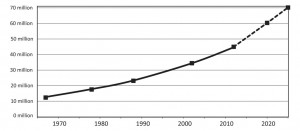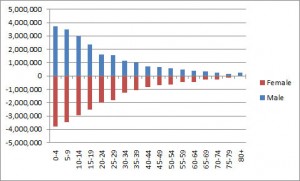by David Brewin
Human Rights Violations
According to a report published in April by the Legal and Human Rights Centre (in collaboration with the Zanzibar Legal Services Centre), human rights violations increased in 2012. Incidents of mob justice among civilians escalated at an alarming rate, with a reported 1,234 people attacked, including persons suspected of theft and witchcraft. Nine law enforcers were also killed by mobs.
The survey showed that Mara Region was among the most violent areas with an average of 40 people being killed annually. More than 1,000 school girls were affected by Female Genital Mutilation (FGM) in the region by the end of last year.
“They should be beaten”
Prime Minister Mizengo Pinda caused controversy in June when he remarked in parliament that troublemakers should be beaten, adding that “tumechoka – we are tired”. Human rights activists and opposition politicians feared that the Prime Minister was giving instructions to police and other security forces to get tough with protesters, despite existing concerns at heavy-handed police tactics that had already led to several deaths.
The Tanganyika Law Society and the Legal and Human Rights Centre filed a petition at the High Court against the Prime Minister. They ask the court to order the Prime Minister to publicly denounce his statement on the grounds that it infringes human rights, the principle of the rule of law, and the constitution.
The petitioners expressed their concerns that the police would take this as a lawful order and implement it in the form of arbitrary and extrajudicial beating and torture of innocent citizens.
Roman Catholic Church in Arusha bombed
Three people were killed and 60 were wounded in a bomb attack on a Catholic Church in Arusha in April. The Vatican’s ambassador to Tanzania and the Archbishop of Arusha were in the church at the time. The ambassador escaped unhurt during the attack, which took place as he was presiding over the consecration of a new church in the city’s Olasiti area. Eye witnesses said the attack took place at around 10.40am as parish members and other Roman Catholic believers converged at the main door to witness the opening ceremony.
President Kikwete condemned it as a ‘terrorist attack.’ After cutting short his a three-day state visit to Kuwait, he visited the relatives of the three people killed in the blast and later visited the injured at Mount Meru and St Elizabeth hospitals in Arusha.
No group admitted to being responsible. A Muslim Sheikh said that a theory that the attacks were the result of religious tensions ‘was becoming less certain.’ Arusha Regional Commissioner Magesa Mulongo told President Kikwete that nine people, including three Tanzanians, had been arrested in connection with the attack.
Defence and National Service Minister Shamsi Vuai Nahodha said that Tanzania was experiencing the most trying times since independence due to persistent attacks on churches and clerics and threats to peace and security nationwide. To avert a total breakdown of peace, religious leaders and politicians must avoid making statements that might incite the people into violence, he said.
Prime Minister Pinda said “People will not stop being Christians simply because some thugs are killing clerics and vandalising churches, so what is the point?” When he visited the injured at Mount Meru hospital, he directed doctors to keep the shrapnel removed from the bodies of the victims and hand it to investigators. “We want to establish the kind of bomb which was used,” he added. “We want to know if it was made locally.”
Arusha bomb blast at political meeting
Two people died, and several were injured in Arusha on 15 June in a bomb blast at Kaloleni playground, the venue of a Chadema campaign meeting prior to council by-elections. The bomb was hurled on the spot where senior leaders were seated, including the Party’s National Chairman Freeman Mbowe and Arusha MP Godbless Lema.
A few days later Arusha was in chaos as police and mobs fought running battles over the meeting that had been declared illegal. Business came to a standstill as riot police fired teargas at Chadema supporters determined to defy an order to leave the scene of the grenade attack. The confrontation between police and the protestors extended to the inner city, mainly targeting people in groups. Other law enforcers appeared to fire into the air to scare anyone trying to get close to Kaloleni. Traffic came to a standstill along the busy Moshi-Nairobi highway as police confronted youths who had barricaded the road with stones.
Tundu Lissu, the opposition chief whip and MP for Singida East, and three other Chadema MPs Mustapha Akunaay (Mbulu), Said Arfi (Mpanda Urban) and Joyce Mukya (Special seats) were arrested for addressing an illegal assembly.
Mtwara
This town has seen several riots since January following the government’s announcement that newly discovered gas offshore would be sent through a $1.22 billion pipeline to Dar. At least three people died, CCM offices and houses were set on fire, and journalists were reportedly targeted in the most recent incident in May, shortly after Energy and Minerals Minister Sospeter Muhongo announced in parliament that the pipeline would be built as planned.
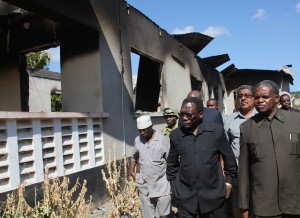
Prime Minister Mizengo Pinda visits the fire damaged courts in Mtwara following the rioting – photo State House
To help pacify the people, Prime Minister Mizengo Pinda later visited the town to lay the foundation stone for a large cement manufacturing plant providing 1,000 jobs and a production capacity of three million tonnes of cement annually. The PM urged Mtwara residents to be patient and support government plans which would improve the economy of Mtwara and the nation at large. He also revealed that so far there were over 50 firms interested in investing in Mtwara Region.
In parliament several MPs said that the Bomani Commission had recommended that revenues should be shared between the Central Government and the local communities affected, and that the latter should receive 40% of the earnings.
Riots over cashew nut payments in Lindi Region
About 20 houses have been burnt down in May by protesting cashew nut farmers, the local MP told the BBC. Faith Mitambo said two buildings at her home in Liwale town had been set alight and that other houses targeted belonged to CCM members.
The trouble began after payouts to farmers for their crop were less than the price agreed last year. The protests, involving groups of young men, began in villages and reached Liwale town by the evening. A resident of Liwale told the BBC that there was a sense of fear in the town and police had fired tear gas in the market to stop crowds gathering.
Thousands of small-scale cashew nut farmers sell their crops to cooperative societies at an agreed price of TSh 1,200 per kg. Towards the end of last year, the farmers received the first instalment. But when representatives from the co-operative societies went to Liwale to pay out the second and final instalment, the terms had changed. The farmers were offered half or less of the outstanding money as the prices had fallen on world markets.
Acid attack on British women in Zanzibar
Two 18-year-old British girls on holiday in Zanzibar in early August were doused with acid (or other corrosive liquid) by two men on a motorcycle in what President Kikwete described as a “shameful act.” One was seriously burnt and the other had been immersed in the sea immediately after the attack which helped dilute the acid. Both were treated in hospital in Zanzibar before returning to UK.
The incident received much publicity in Britain and the Zanzibar authorities immediately offered a reward of £4,000 for information leading to the capture of the attackers. The young women had been working as volunteer teachers in Zanzibar.
There were all kinds of theories as to who might have been responsible according to the London Times. The police launched a massive manhunt, arrested various people including some citizens of the Emirates and Saudi Arabia, but they were subsequently released.

